Jeff Grubb's Blog, page 12
April 20, 2023
Books: Spies and Lies
Slow Horses by Mick Herron, Soho Press, 2010
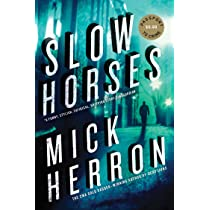
A Legacy of Spies by John Le Carré, Penguin Books, 2017
Provenance: I blame The New Yorker for this one. They had an article on author Mick Herron, talking about how he was an heir to John Le Carré in the genre of spy thrillers. OK, on that note, I went hunting for Herron's first book, and found it at Apparition Books in downtown Renton (who do not have a web site. Sorry). Apparition is a curated bookstore that has a lot of good books in good condition. On completing Slow Horses, I went back to see if they have the second book of the series. They didn't, but did have one of John Le Carré's last works. So I picked that up instead, and used it as my airplane book for the trip the Georgia.
(And yes, I prefer to read books on the plane as opposed to using the tablet. I don't worry about battery life or being distracted by other apps or having to turn it off during takeoffs and landings. And if the book is lost, it is OK - it's a paperback.)
Review: Slow Horses is Smiley's People meets The Office. No, really. The title is a play on Slough House, the nickname of a branch of MI5 that is so remote from the sources of real power in the Ministry that it might as well be in Slough. This is where they put the Joes that screwed up, the ones they can't fire outright. They give put them in the worst, most tedious, most menial jobs in the hopes that they will take the hint and quit. River Cartwright is one of those Joes who apparently screwed up and as a result he works grudgingly with others who have committed sins great and small, under the relatively inert leadership of Jackson Lamb. Their tasks are gruntwork - checking IDs, monitoring BBSes, investigating lapsed visas. They exist in the after-eleven world, where the threat was not communism but religious maniacs. They are prepared for foreign terrorism.
What they are not prepared for is the home-grown type. They also are not prepared for their own bureaucracy, more concerned for turf wars and protecting their own bureaucratic buttocks than in doing their jobs (actually, they feel that protecting their public-funded posteriors IS their job). The mayhem that ensues is mostly self-inflicted, but it is the Slow Horses, and Jackson Lamb in particular, who ultimately triumph. Mostly.
I like the characters and the plot. The author drives me particularly crazy by having the characters learn things which are then not shared with reader. We are frozen out. Someone is about to share some important bit of information and the scene changes. Someone dies - Who? Tell you in about 20 pages as an offhand remark. And the author deliberately misdirects, so that you think one thing when the truth is elsewhere. These literary trick raises tension through this concealment, but it excludes the reader from the journey. That's a personal peeve, but it caused me to roll my eyes a few cycles.
One thing I did like was the sense of place, in the Modern London. William Gibson is one of his books described London as an alternate reality to the States. Things are the same, but also very different. And that alien familiarity may account for some of the popularity of all things British on this side of the pond, from Monty Python to Harry Potter. Things are familiar, but different, a modern fantasy setting of sorts. Herron describes and describes well and sells the setting hard. I know the area that Slough House is located, as the original Grub Street (now Milton Street) is in the area, as I walked that area of London the last time I was there.
Let me praise with faint damns - It was worthwhile, and I will probably hunt down the next one.
But with all that in mind, I turned to A Legacy of Spies, going to original-flavor spy novelist Le Carré in one of his last books, published seven years after Herron's first, and quite frankly, discover that the original version still has the juice after all that time. Le Carré is the grand old man of spy fiction, defining a lot of the terms used and setting the entire sphere of post-war spycraft as a blatantly amoral game where the greater good outweighed any personal qualms. At its core has been (often) George Smiley, who has been the master web-spinner at the heart of the Circus.
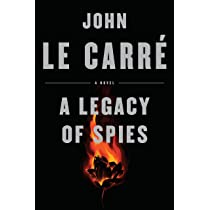 A Legacy of Spies is related to us by Peter Guiman, who has been Smithers to Smiley's Burns in earlier books. Peter has been Smiley's agent, bag-man, and aid-de-camp for years. Pater has been hauled out of retirement in Brittany by the next generation, who is dealing with accusations involving his time at the Circus. Half of the story is Peter talking to the modern lawyers, and half is his memory of what really happened back then.
A Legacy of Spies is related to us by Peter Guiman, who has been Smithers to Smiley's Burns in earlier books. Peter has been Smiley's agent, bag-man, and aid-de-camp for years. Pater has been hauled out of retirement in Brittany by the next generation, who is dealing with accusations involving his time at the Circus. Half of the story is Peter talking to the modern lawyers, and half is his memory of what really happened back then.And Peter lies. But unlike the lies Herron presents, Le Carré takes us hostage within Peter's narration, so that we KNOW he is lying (usually when talking with the lawyers and the modern agents). Peter dodges, he takes refuge in semantics, he seeks to protect Smiley (who may or may not still be alive at this point), he tries to protect the legacy of the dead. As a result, you the reader are let in on what is going on, or at least, what Peter thinks is going on. And to be frank, it feels at the end as if Peter is disassociating completely from reality, and this most unreliable of narrators may be utterly unreliable.
And its is great stuff. Yeah, knowledge of what has gone before is helpful/recommended (I brushed up against it back when Alec Guinness was playing the role), and the book does a lot to provide connective tissue for a lot of the other series. But Le Carré remains an amazing writer and his work is an engaging as his characters are morally grey. It feels like the wrapping up of loose ends (Le Carré died in 2020, and while this is not his last book, it is the last one featuring Smiley's People).
So, end result? Herron is perfectly fine if you're willing to be brought along for the ride. Le Carré remains the champion, in part by laying things out exactly, and letting you come to your conclusions.
More later,
April 18, 2023
The Political Desk: Pop-Up Funding Edition
What, another ballot in the mail? Such is the price of Democracy.
And speaking of price, there are only two items this half-year ballot locally, and both of them involve funding. This time, the voters pamphlet came in the same envelope as the ballot itself. And going through the arguments, I'd have to say the arguments AGAINST these measures gave me the best reasons to vote FOR them.
The easy one is approving a bond issue for Kent Schools - Proposition No. 1 General Obligation Bonds. It authorizes half a billion-with-a-b worth of bonds paid off over 21 years. We sell the bonds now, get the money for improvements, and pay them off over time to the bond-holders. The school district increases the property tax rate to pay for this, but in this case, total property taxes would go down, not just because of old bonds being paid off, but because property values have gone up over the years.
The arguments for and against are here. The arguments for are pretty much along the lines of "this is a good thing", and provides a long list of needed physical improvements. And yeah, the school behind our house still is using the "temporary classrooms" that were there 20+ years ago when we moved in. But the argument against are off-the-wall AM talk-radio nuts. No, seriously. Go read them. I'll wait. I can't properly do them justice. Government, as you know, is a left-wing scam, and this is a socialist power grab that will bankrupt you. Educating kids? That's just a pet project. Maintenance on older schools? That's dictating how your kids should be educated. Putting it to a vote? That's just intimidation.
Seriously, folks? I mean there are some good reservations here - it is half a billion dollars from a 21 year bond issue. And I am not seeing anything about hiring or maintaining teachers - it is mostly about the physical plant. But this bilious bloviating is right out of the crazy-conservative playbook. They opposition statement could make a sane, reasoned argument. It didn't.
Needless to say, I recommend voting YES on Proposition No.1 General Obligation Bond.
But that's just the hyper-local matter. On the King County level, we have another, DIFFERENT Proposition No.1 Crisis Care Centers Levy. This one increases our property taxes for nine years county-wide to fund behavioral health services. The Seattle Times and the Stranger are both boosting this, and they never agree on anything, and the Times has been running articles on the current state of affairs and why we could use this. Right now, available beds for mental health are lower than they were 20 years ago, and there is a 41 day wait for one. That's not particularly good, and puts a strain on everything else, in policing, hospitals, and other services. So yeah, I'm good with this.
The opposing view is not as flaming as for the one for the Kent School District, but still misrepresents what is going on, and declares that once the government gets the money, they will go spend it somewhere else (no word on whether mental health is a good or bad thing, or if we are taking the right approach to it). The argument they put forward, that the government can hot-swap funding at will, is an interesting one. Pity they don't give any examples that the county government has done this in the past.
So, yeah, I recommend voting APPROVED on Proposition No. 1 Crisis Care Centers Levy (though to be honest, I don't know why one is a YES/NO vote and the other is APPROVED/REJECTED).
And as a side note, one of the sage heads submitting the statement in opposition is Tim Eyeman, noted initiative launcher and apparent office chair thief. One of his few victories has been to tag onto the ballots useless and misleading push-polls that let people vent about taxes. The measures have no teeth, but can be used to bludgeon anyone trying to raise funds. Finally, the State Legislature is getting rid of this swollen appendix of a measure. Here's a way-too-detailed article on the situation. After this is signed off on by the Governor, you will still be able to find out about tax increases- there will be web sites and QR codes and referenced in the Voter's Guide - but you will no longer have to put up with meaningless chaff on the ballot. And that's a good thing.
And that's it for the off-off-off election cycle. It is due next Tuesday, and all you need to do is drop it off at the many ballot drop boxes or put it in the mail. You don't even need a stamp. But don't worry, primaries are right around the corner.
More later,
Coming Attractions
How did the reading go? It went very well, thank you, and I appreciate the actors who read our works. It is good to hear our lines in the voices of others.
Next in the queue, Jim Ward, Ed Greenwood, and I are returning as "The Wizards Three", where we talk about the Realms, Greyhawk, and Dragonlance. Be there or be square!

More later,
April 12, 2023
Con Report - Gary Con XV
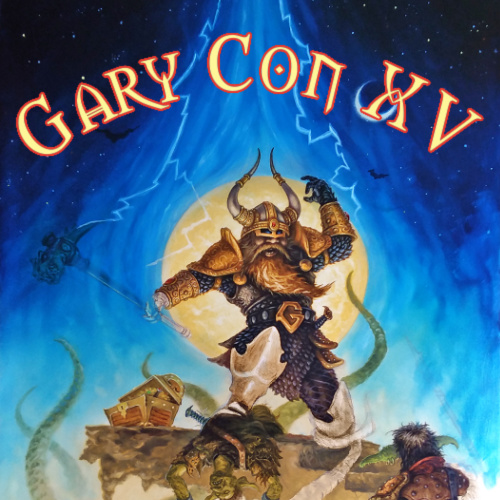 This one is a little overdue, but so be it. I want to cover it anyway.
This one is a little overdue, but so be it. I want to cover it anyway.I will fess up - I am not a big convention-goer. I make it to one, maybe two a year. Part of it is because of limited vacation time, and part of it is because I am homebody. Often when I go somewhere it is because I am sent as part of my job, or asked to attend as a guest.
But I have to say that Gary Con XV was an excellent convention, one of the best I've attended.
Gary Con is in Lake Geneva, Wisconsin, the birthplace of Roleplaying Games. It is named after Gary Gygax, co-creator of D&D. But if you're reading this, you already know that, right? In any event, Gary's son, Luke, put together this convention to celebrate Gary, his creations, and the entire industry he founded.
Gary Con XV was held at the Grand Geneva, just east of town. Back in the Elder Days it was the Playboy Resort, and while expanded and renovated, it has more than a touch of that 60's mystique (OK, one of the bar staff there was a former bunny, I found out). It is an extremely beautiful structure, and as a venue was perfect for the convention. The entire complex is done in Frank Lloyd Wright's "Prairie Style", which means low buildings that hug and complement the land. I like that, even through I had to deal with steps to get between buildings.
The Grand Geneva staff were amazing and efficient. I've been to a lot of conventions over the years where the staff tolerates the gamers, or at best treats them like visiting bathroom fixture salesmen. The staff here was engaged with the participants, warm, and friendly. Plus, they had daily maid service, something practically extinct in modern times. Bonus round? When the check-in lines got long, they offered champagne.
And there was a lot of food and drink. The three restaurants on-site were hotel-expensive but not horribly so. In addition, the Gary Con Staff arranged for feeding stations around the convention itself, selling hot food and cold drinks. Plus service carts that prowled the gaming spaces. And that first Wednesday night, when the registration lines were long they were selling beer from coolers in the hallways.
I packed myself with too much during the day, trying to keep the evenings free. I ran the Ravager Trilogy, which I realized was 40 (!) years old, namely when a fan I had sent a playtest copy to all those years ago brought it in for an autograph. It has been my "old reliable" that I use when I go to a new convention, and fits nicely into a 4-hour slot, but I might need to retire it. Maybe revise it to be a 5E version. Maybe.
I also ran "Under An Angry Star", which was an Al-Qadim/Spelljammer mashup that I wrote for the LUCCA convention in Italy. Going through it, I think it could stand an upgrade and revision, which may be a good excuse to expand it into a three-session set. Again, Maybe.
One of the highpoints of the weekend was running (briefly) in Jim Ward's might Gamma World campaign. James was eloquent and entertaining as always, leaning to random and relatively fatal encounters. I ended up getting shot by another player at the table, a mutant otter with a pulse rifle, but fun was had by all. For my pain, Jim presented me with a small autographed skull.
 Some SwagAlso important for me was seeing folk I had not seen in literal decades. I worked in Lake Geneva for TSR, but had not been back for 20+ years. We held a TSR Alumni party on-site and it was a great opportunity to catch up with so many old friends. One of them, Kevin Melka, late of the RPGA, was passing out 3D-printed Cthulhus. He gave me a rainbow one.
Some SwagAlso important for me was seeing folk I had not seen in literal decades. I worked in Lake Geneva for TSR, but had not been back for 20+ years. We held a TSR Alumni party on-site and it was a great opportunity to catch up with so many old friends. One of them, Kevin Melka, late of the RPGA, was passing out 3D-printed Cthulhus. He gave me a rainbow one.And I was delighted to see Zeb Cook win a Lifetime Achievement award. I thought that was great.
Oh, and we got to see the D&D Movie early at a local theater north of town. It was a fun movie, and I got a Dragon head dice container.
Downsides? Very few. I suppose the fact we got about 6 inches of snow on Saturday. Fortunately it was a wet and heavy snow, and the temperature warmed later in the day, so I could push it off easily. But if you're going to rent a car in Wisconsin in March, make sure it has a snow brush.
And there was concrud fallout. Some friends had a nasty cold/flu afterwards. A lot of people tested positive for COVID. I escaped both, but have been a little brain-fuzzed for the past week. I don't know if should blame the gatherings or not. But I also left energized, and wanting to address some the half-dozen concepts I've been playing around with for a while
So, in summary - great convention, well-run, saw a lot of old friends. Kudos to Luke Gygax and an extremely talented team in putting it all together.
More later,
April 10, 2023
Return of the Quills
*Ahem*'
I've mentioned before I have a playwright's group, the Quills. Last year we put together an evening to present our new works. And we're doing it again. This is a reader's theater, which means that we'll just be reading the plays, without any blocking, costumes, or other stuff. If you're in the area, come see us!
The Quills New Works Evening
Monday, April 17th, 2023
6 PM to 8 PM
Edmonds Driftwood Players
(Wade James Theater)
950 Main St.
Edmonds, WA
The Quills is a forum for amateur playwrights in the Seattle area. Please join us for a public reading of our new short works and scenes from longer plays in process.
Free—but we will be soliciting feedback.
Masks are requested but not required.
March 11, 2023
Book: Planet of Women
Unnatural Death by Dorothy L. Sayers HarperPaperbacks, Original copyright 1927
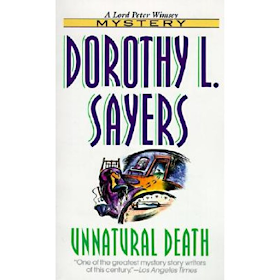
Provenance: The Crazy Book Lady, a used bookstore in Acworth, Georgia. I wanted to pick up a back-up book when I was down there (you readers know what I mean - a book for just in case I finished the book I was reading). The shop is in a small mall off the main road, noted only by a simple sign declaring "Books", and also handles U-Haul rentals. Could not find the next Mick Herron book, and did not feel like another LaCarre, but did stumble across a Sayers that I had not yet read.
Review: Let me digress immediately. I always found the Bogart version of the Big Sleep (1947) interesting for many reasons, and one of them is the power of women in the film. Bogart is Phil Marlowe is at the center, sure, and we also have the old General's two daughters (Lauren Bacall and Martha Vickers, who throw themselves at Marlowe) but also the chief villainess (Agnes Lowzier, who does not), and Dorothy Malone as the bookstore owner who looks beautiful without her glasses. And a female cabbie (Joy Barlowe) for a short bit. And what struck me at the time was that Bogart/Marlowe just pops into the cab without giving the fact it was driven by a woman a second thought. It is a movie, though with a male lead spends most of his time interacting with women.
And that is the same vibe I got from Unnatural Death. Yes, Sayers did a great women-centric book in Gaudy Night, and some day I may even talk about it. But the plot of Unnatural Death is controlled by its women, and Lord Peter Wimsey and his buddy Inspector Parker are often secondary and reactive to their actions. I fact, most of the men come off as second-best - they are there where their positions of power, banned to women, are needed (doctors, lawyers, law enforcement), but are come off the worse for wear (haughty, pedantic, and/or fools).
Let me lay out the plot in brief. This is the most murder-mystery-like of the Lord Peter books in that it obeys a lot of traditional tropes. By this point in his career Lord Peter has established himself as an effective consulting detective, making mysteries and murder his habit. A discussion of "perfect murders" that no one even considers a crime occurs, boosted by a chance encounter at a restaurant, which puts him on the case. An old woman dies. She has cancer, but her demise is still sudden. She has stated that her Grand-Niece inherits all, but refuses to make a will. And there is enough little weirdnesses around the situation that Lord Peter, with Parker in tow, investigates.
And part of that investigation is assigning a female operative to the deceased's home town. Miss Climpson is a proper, dedicated, older, single woman with a High Anglican background and a rational mind. Peter puts her in town so she can ask questions that a man would not get proper answers about. And she falls in with the gossipy small-town lift of the community and shows herself to be every proper bit an investigator (by the way, she apparently predates Miss Marples by a couple years, though she is late to the field of Lady Detectives in general). The end of the book is a cascade of her convincing herself to put herself in harms' way while Wimsey and Parker are still sorting out threads.
And there is a lot of queer-coding going on here. Many of the women have no declared use for men and are pretty happy with that - they are fish without bicycles. And a number of them have better relationships with other women. The elderly deceased had a healthy and active relationship with a suspect's grandmother (who was (coding) an expert horsewoman). Peter's chief suspect leaves town with a younger woman, intent on purchasing a egg farm far away from any of the people they know. The phrase "equal of any man" is invoked a couple times, and always making the male speaker look like a fool. For a book almost a hundred years old, there are lot of signposts out there, and the question arises if there it was as obvious back then as it is now.
The murder itself (and yes, there was an initial murder - if fact, several over the course of the book) ages less well. The method of dispatch is obvious to our modern eyes, since we have seen it played through so many times in popular media since (along with questions of how effective it would actually be in the real world). Wimsey pieces together the clues with glacial slowness, complete with a moment of "Ah! I had forgotten about this one piece of then-public information" that provides a motivation as to why the old woman had to die RIGHT NOW as opposed to letter nature (and cancer) take its course.
All in all, it is Sayers, and as such has a richness and depth of Interwar Britain. In this case, the sudden downturn of the male population in the years after the war, and the challenges and opportunities that presented to women. As always, worthwhile.
More later,
March 8, 2023
Life in the Time of the Virus: Becoming a Statistic
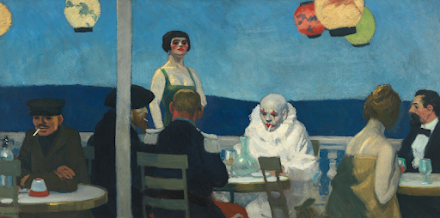 Soir Bleu (Blue Evening) by Hopper, 1914Oh, how the mighty have fallen. I have COVID.
Soir Bleu (Blue Evening) by Hopper, 1914Oh, how the mighty have fallen. I have COVID.Worse yet, I had COVID and traveled out of state to a wedding this past weekend.
So, here's the story. TWO weekends back I attended, unmasked, a "Nerd Party"/book signing down in Kent, and I think that's where I picked things up - the time frame matches up. The Wednesday following I had a scratchy throat and a stuffy head. To be honest, nothing out of the ordinary for after I do a convention where I talk with people a lot. It was bad in the morning, but pretty much evaporated by the afternoon. No fever. No diarrhea. No effect on sense of taste. No problems breathing. By Friday it was just merely irritating, so I flew 5 hours to Atlanta (masked on the plane) and attended the wedding of my youngest niece (not masked). Hugged people, celebrated, schmoozed. I warned some people early on I was "getting over a cold." Because that's what it felt like. How little I knew.
And while waiting in line at the airport to LEAVE Atlanta, I saw a Facebook post from a friend who says he has tested positive. So I texted Kate to that effect, and came back to Seattle, totally masked up. She had told me she had "caught my cold". She tested positive with an old test. I went out and got some new tests, shoved the probes up my nostrils and.... yeah, I'm positive. I'm positive I'm positive.
So how is it? It feels like a cold. I've had nasty ones. It did not lay me out (though I used it as an excuse to a nap). I've been vaccced and boostered, and while it ultimately did not give me Plate +3 level protection, it does feel like it has pretty much limited the effects. I mean one of the points of the vaccination is to prep the body to beat back the real thing. And I honestly felt more tired and brain-foggy from the vacc than from the virus when it showed up.
But I sent out the emails to others that were at the book event, and those at the weddings. Fortunately I didn't hug a lot of people at the wedding, but I did hug people that I was close to. Brother, sister, sister-in-law. And the bride. I should of opted for the mask, but no one was masking up. And I felt that if COVID responded poorly to an alcohol-based environment, I had that more than covered.
And I feel phenomenally stupid. I mean, I've spent a couple years observing proper protocols, and had this entire Protestant-Work-Ethic approach to health - I was going to get through this through sheer strength of moral fiber and applaudable caution. I was kinda proud I had not succumbed. Paladin-level virtuous, even. Yeah, we declared the crisis over and many/most have tucked the masks away, but it is still out there. Even if the present form feels less virulent and deadly, and it is not putting as many people in the hospital (or the grave), it is still sending a healthy number into unhealthy crises. But knowing ALL THE RISKS I still thought it was "just a headcold" and went off to a wedding.
So what now? Isolation and masking for the moment. Monitoring to see if it gets worse (that can still happen). On-line conference with a health professional (we're far enough away from initial onset that anti-virals will not help). Mucinex for the stuffiness. Taking care of the Lovely Bride. Staying the heck away from people, which has become second-nature to me. I work from home and the work hasn't suffered (much) from the amounts of phlegm in my system. I'm feeling a little more snarly than usual, but that is likely more on me than on the virus itself.
And I have "All-Star" by Smashmouth running continually in my brain. Oh, the horror.
So yeah, folks, keep the masks on, keep your head down, keep yourselves safe.
And it's NEVER just a headcold.
More later,
March 2, 2023
No Quarter: Next Gen II
We've been talking about the design of recent collectable quarters from the US Mint for some time. We've done States. and we've done National Parks. And most recently I've started in on the American Women series, which commemorates famous woman over the course of US History.
Now in the many years of these programs, I have to admit that the carving qualities and depth of design has improved dramatically, so there's less to mock here than I would prefer. And while that's a good thing from the design aspect, it is less so from the entertainment element. Let that be so. I will persevere. So you get a little more history lesson these times out
Oh, and by the way, the Anna May Wong quarter from last year really improved this old movie star's visibility, which says in part why these quarters are a good this. Anyway, here's the ratings:
Way Cool =A
Not Bad = B
Just Average (also known as Meh) = C
Kinda Lame = D
So Bad the Designer Should Go Home and Think About What They Did + E
Bessie Coleman(1892-1926)

Bessie Coleman was the first female African American pilot, as well as the first female Native American pilot. Her male predecessors are apparently up for debate, but include Emory Malick and Eugene J. Bullard. Coleman herself had to go to France to learn how to fly (America being non-too-receptive to minorities OR women in the air), and returned to do demonstrations in America and to speak. She died (as a passenger) in an air crash in 1926
The coin itself is … OK. It shows Ms. Coleman reaching up to adjust her flight goggles, which is a good pose, but due to the limitations on the coin itself, her right arm and hand do not look clear, and I had to expand the image to figure out what was going on over there. Still, it is good take on the three-quarters view we've seen on other quarters. The plane in the background is, I believe, a Curtiss Jenny (Curtiss JN) which was used to train most of the US WWI pilots and was used in the post-war years by barnstormers and mail flyers, among others. Where the coin works best is in the "right stuff" style for the name (and when she got her pilot's license). OK, but a bit muddled and lumpy in her flight suit.
Rating: C
Edith Kanaka'ole (1913-1979)
Edith Keona Kanaka'ole was a teacher, chanter, and dancer, and was responsible for the preservation and blossoming of Hawai'ian culture over the middle decades of the past century. She assisted in the development of Hawaiian language programs, and taught ethnobiology, language, and Polynesian history. She helped stem to the tide of extinction of Hawaiian culture and language.
The coin itself is pretty good, melding Ms. Manaka'ole with the land itself. She looks a little grim and stoic, though other photos I've found seems to be warmer. The inscription at the bottom translates as "Granting the Wisdom", which is a pretty fair estimation of her legacy. I think her name is going to get lost in her hair/landscape, but moving the various text around the coin is a good call. I don't remember the "cents" sign showing up since coins a hundred years ago, but it works here.
Rating: B
Eleanor Roosevelt (1884-1962)
If you're going to do a series on important American women, of COURSE you're going to do Anna Eleanor Roosevelt. She is the most notable and effective activist First Lady since Dolley Madison evacuated the White House, and she set the bar for all presidential spouses since then. Her work during the war is commendable and is exceeded only by her later work with UN and the Universal Declaration of Human Rights. She ALREADY has a coin, though it is one of the Presidential Spouses $10 series that never saw circulation, and she, apart from all the other first ladies, has her own statue in her husband's memorial in Washington DC.
All that said, which justifies her in "Wikipedia Notability" terms and merits her being on more than one coin, this is not a great coin. It captures the main elements of Ms. Roosevelt's political career (The globe, justice), but it is cluttered as a result, with a lot of text on it, and some of it will be lost in the folds of her blouse, much as for the previous Edith Kanaka'ole coin. Breaking the border of the globe with her head and hat does a lot to elevate it beyond the traditional portature, but I think it's a bit cluttered.
Rating: B
Jovita Idar Vivero is one of the entries here I had to dig down to get to. A journalist and campaigner for Mexican-American rights, Ms. Idar ran newspapers in Texas and fought for less fortunate Chicanos and women. I am always in favor of currency that features writers, reporters, and editors, and Ms. Idar was all three.
I like this coin. A lot. One of the challenges of these quarters is that there is so much boilerplate text that HAS to go on them (United States of America, E Pluribus Unum, Denomination), plus necessary text of identification and often achievements, that the results can be cluttered. This design moves all of that text, and more, onto Ms. Idar's blouse, in effect wrapping her with her own achievements. It also leaves some impressive white space on both sides. And the portraiture itself is very impressive - portraits on these coins are a challenge to avoid the dead-eye stare that plagues, say, the Presidential Dollars, but here it pulls it off. Impressive and a welcome change from the traditional presentation.
Rating: A
Maria Tallchief (1915-2013)
 Maria Tallchief was the first American prima ballerina. Not the first Native American prima ballerina nor the first prima ballerina of color. The first American prima ballerina. Now, ballet is one of those subjects that I am particularly and enthusiastically weak on, but I recognize the importance of the achievement, and doing the digging on the wiki, am deeply impressed with her accomplishments.
Maria Tallchief was the first American prima ballerina. Not the first Native American prima ballerina nor the first prima ballerina of color. The first American prima ballerina. Now, ballet is one of those subjects that I am particularly and enthusiastically weak on, but I recognize the importance of the achievement, and doing the digging on the wiki, am deeply impressed with her accomplishments. The coin, though, does not do her justice. The pose is supposed to represent a grand jete (a mid-air leg splitting leap for us muggles) but comes off as static. Her headpiece (I am guessing here) comes from Stravinsky's The Firebird, but looks incidental and does not contribute to the sense of motion at all. Good points for framing her in the spotlight, and for including her Osage name ("Two Standards", or "Two Worlds") on the coin as well. It is perfectly serviceable, but I think it is missing the sense of motion that a ballerina demands.
Rating: C
That's it for the second round - tune in next year for five more. Last year's Anna May Wong coin has made it into circulation and looks great, so keep checking your change.
More later,
February 19, 2023
Game: Imperius Lex
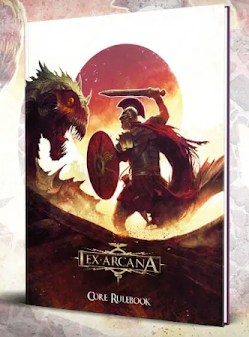 Lex Arcana: An Empire Without End Core Rulebook by Leonardo Colovini, Dario De Toffoli, Marco Maggi, and Francesco Nepitello, 2019 Quality Games S.r.l.
Lex Arcana: An Empire Without End Core Rulebook by Leonardo Colovini, Dario De Toffoli, Marco Maggi, and Francesco Nepitello, 2019 Quality Games S.r.l.Lex Arcana: An Empire Without End Quickstarter by Marco Maggi, and Francesco Nepitello, adventure by Giacomo Marchi, 2019 Quality Games S.r.l.
Long-time readers know that I will often talk about newly-arrived games in the Grubbstreet household. Many come in. All are flipped through. Some are read. A few are actually played. When I talk about the new arrivals I don't go into a lot of details and hesitate to call my write-ups reviews. The big reason is that games should be played, and reviewing a game based on the text alone is like reviewing a play based on its script. It can be done and done well (look at the voluminous amount of Shakespeare commentary), but doesn't get the experience of the game itself. Similarly, reviewing a live play is like reviewing a performance, where a lot of elements come into play, but I think it is more honest to take it out for a spin.
Anyway, this is a review. I had the chance to run my regular Saturday night crew through the Quickstarter, and got a fair idea of both the mechanics and the game world. So here goes.
Lex Arcana is the X-Files in a Roman Empire that never fell. The year is 476 CE in our parlance, which was when the (Western) Roman Empire fell. In this world is is AUC (Year of the City) 1229, and Rome is still chugging along at its maximum empirical extent. This is mainly because a) there are gods, and b) there is divinatory magic that allows Rome to avoid letting things fall apart.
That doesn't mean there are no threats to the empire, and that's where the Player Characters come in. You are custodes (watchmen, guards, agents) of the Cohors Auxilaria Arcana, which is a special detachment of the Roman Legion, recruited from across the Empire to deal with supernatural dangers. You've been touched by the gods and act as agents of Rome. You may be sent off as the result of a vision, an omen, or a report from the hinterlands, and given wide leeway in dealing with threats to the Empire.
You have Abilities (Called Virtutes) and Skills (called Peritiea) Ah, that's another thing. Everything is named in Latinate terms, which helps in getting the proper feeling but can create havoc in play. The good news is that most of skills and abilities make sense to a non-Italian speaker - your coordination ability is Coordinatio, your combat skill is de Bello. The bad news is they truly need a Pronunciation Guide for the poor semi-literate English-speakers. My dog-latin would make a hound howl, and I am afraid I risked one of Jove's Thunderbolts mangling the language. The game master, by the way, is called a Demiurge.
Anyway, you have "Dice Points" in your Abilities and Skills, and this is interesting. You can roll any type of dice (d2, d3, d4, d6, d8,etc...) for an ability test up to the maximum number on that dice. So with a Coordinatio of 12, you can roll a d12, or 3d4, or 2d6, or a d10 plus a d2. It is an interesting mechanism. Adding to that is that the dice "explode" (like in Spelljammer's smoke powder rules) - if you get a maximum on your dice (all three d4s come up 4), you roll again and add that to your total. Which sometimes is overkill, since you will likely have made the Difficulty Threshold already.
Results also come in degrees of success - You can increase damage or get more information if you beat the Difficulty Threshold by a sufficient number. For every three points you get an additional success. In combat, both sides roll their de Bello, and then high score wins damaging the loser (tying rolls do nothing - you are clanging swords at each other). Degrees of success can multiply the damage. Shields can affect whether damage is done, and armor reduces the damage itself.
One nasty bit is that multiple attackers on the same target add their rolls over a single round (tempo). The first attacker makes his de Bello, then that result is added to the next attacker's score and so on. So a mob can really overwhelm a solitary defender (One of the group was hit hard by a number of giggling child-demons and almost got wiped out).
 In play, all of the above works out pretty well. As Demiurge, I unleashed this on my regular Saturday night group - 3 or 4 players, which was a nice number, and used the Quickstarter adventure. The Quickstarter has all the basics from the Core Rules, and adds a few wrinkles, like offering a wild card deck of things the player can do to either speed or hinder the plot (Sortes). So here be some spoilers in this discussion, but I will try to make it light.
In play, all of the above works out pretty well. As Demiurge, I unleashed this on my regular Saturday night group - 3 or 4 players, which was a nice number, and used the Quickstarter adventure. The Quickstarter has all the basics from the Core Rules, and adds a few wrinkles, like offering a wild card deck of things the player can do to either speed or hinder the plot (Sortes). So here be some spoilers in this discussion, but I will try to make it light.The group was sent by their local magister into long-conquered Gaul to check out a vision he had. They find a bandit lord who seems to be a lot more charismatic than he has any right to be. He is supposedly a "new Vercingetorix" (yeah, I tripped over that name, though I know it from Asterix et Obelix comics), who was the last great Gaulish chief. In tracking the Bandit Lord to his lair, they discover that the Celtic gods themselves are restless and seeking to mount their own resurrections and rebellion.
And the adventure moved pretty smoothly, with a good combination of action and interaction. There are a lot of random tables for the Celtic gods bedeviling the player characters, and not all of them immediately visible, so I chose results as opposed to rolled them. The story line does have a false branch, in that the heroes can explore the west or the east of the main city(my group, of course, investigated both, setting off ALL the encounters in the process). Regardless of choice, you eventually discover an outpost of the Bandits (same encounter regardless) which in turn leads you to their secret base and potentially a big battle scene (which runs pretty well for such a large number of combatants - my team forced them back into their keep and laid siege, forcing the Bandit Lord's surrender, much like Vercingetorix did). Unfortunately, the way the adventure is written, there is a very small chance the player characters find out WHAT was really going on - why this schmoe got the favor of his gods in the first place.
But all in all, it was a pretty good setup (we're a bit leisurely in our play, so we wrapped it up in about four or five nights). It gave some good challenges for a low-level group. There was a good mix of the prosaic and the fantastic. We had to walk through the combat carefully at first, but it came together naturally.
The game has elements of traditional (D&D) style RPGs - the call and respond nature, the game master, the use of polyhedrals, to be comfortable, but enough new material (combat system, sortes) to challenge established players. The setting has great potential (I have a number of additional sourcebooks), and gives the players a strong direction of what they need to do (your boss had a bad dream - go check it out). In the Quickstarter, the differences between the classes is a matter of dice points you have, but that expands out in the core ruleset.
Final summary? Worth playing, and worth playing again. A good time was had by all. Just wish I had taken more ranks in dog-latin.
More later.
February 16, 2023
Book: Burning Down The Haus
From Bauhaus to Our House by Tom Wolfe, Washington Square Press (Pocket Books) 1981
 Provenance: This is again from the collection of Sacnoth, but lacks his normal marginalia and notes. I pulled the book off my bookshelf en route to the bathroom at one point, and it remained there for some time. In fact, I discovered I could ONLY read the book in the bathroom while I was ... otherwise occupied. If I took it elsewhere in the house, I would ignore it as I could only absorb it in small doses, as too much exposure to it raised my blood pressure. Ultimately, though, it has taken me a while to get around to panning it because I had to think about what I hated about it.
Provenance: This is again from the collection of Sacnoth, but lacks his normal marginalia and notes. I pulled the book off my bookshelf en route to the bathroom at one point, and it remained there for some time. In fact, I discovered I could ONLY read the book in the bathroom while I was ... otherwise occupied. If I took it elsewhere in the house, I would ignore it as I could only absorb it in small doses, as too much exposure to it raised my blood pressure. Ultimately, though, it has taken me a while to get around to panning it because I had to think about what I hated about it.Review: Call this a Hate Read. I like Wolfe's work - The Right Stuff is spot-on. Bonfire of the Vanities was great when it was serialized in Rolling Stone (the movie? not so much). But I really didn't like what Wolfe was saying here, and like less the way he was saying it. But at the same time, he has a point - a lot of modern architecture varies between non-descript and outright ugly - big glass boxes without a lot of style or personality.
Mind you, he's not wrong. Our cities have been overtaken by the big glass box. South Lake Union is full of them. But he ascribes this blandification to a group of architects in Germany that set themselves up as the end-all and be-all high priests, and their followers refining the process to the point that they abandon the physical plane altogether and enter the domain of theoretical architecture, which is planned but never built. And ultimately blaming the consumer and end user for not standing up to these architectural bullies.
Wolfe's text is as overwrought as the architectural ornamentation he mourns. His verbiage is dense and he fits as many obscure references in a he can. He comes off as that dinner party bore eager to share his opinions and width of knowledge without regard to who gets in the way. Here's a reference to a medieval philosopher, there a listing of archaic architectural features. And of course the de rigeur Latin reference that no one who went to college in the Midwest would understand. Tempora mutantur.
Ultimately, he is of that brand of Intelligentsia that scores its points by attacking other Intelligentsia. And he had become a brand, right down to his ice cream suit and smarmy literary pretensions. Heck, even the cover design of this particular edition says it is more about the author than the subject.
Much like critiques of modern literature that seem to begin and end at the MFA programs, Wolfe defines his world very narrowly, and then judges it for being so limited. For him, modernism is an exit to nowhere. Frank Lloyd Wright is mentioned but then discarded from the discussion, even though he did some of same overrunning of his client desires as his German colleagues, and in addition contributed more to American architecture. Brutalism doesn't show up because it is not German enough. The Craftsman and Unosian houses don't even exist. The US Steel Building in Pittsburgh, Sears (now Willis) Tower in Chicago and Transamerica Tower in SF were extant when he wrote this, but apparently didn't make a dent in his arguments.
The book was written in the 1980s, talking about movement introduced in the 1920s. We are forty years further along, and I wonder what Wolfe would declare about PPG Place in Pittsburgh (A glass box with crenellations!) or The Seattle Library (which looks like it belongs on the back end of a Star Destroyer) or the multi-colored MOPOP in Seattle (identified by Ron Judd, a local columnist, as "The Wreck of the Partridge Family bus"). What about the sextoy-shaped Gherkin in London? The Cell Phone, which melts cars in the adjacent parking lot? Or that monstrosity of the ultra-thin glass box in New York City, the toothbrush box on Billionaire's Row, a thin glass box that towers over all the other glass boxes?
What would he say about open floor plans? The unification of controls, so only one set of switches commands the lights of an entire floor? The removal of false ceilings of asbestos tile, replaced by exposed HVAC systems, giving large rooms a comfy boiler-room feel. And on the consumer level, the rise of "snout houses", also called "Garage Mahals". where the street view is just he driveway and a garage (and are placed on tiny lots that barely demand a lawnmower).
But I digress.
The thing is, it is not (exclusively) the design habits of the Bauhaus school that evolved us to the current state. Advances in material science and design has brought about this change as well. We have moved from exterior walls as a primary means of support of the structure to facades that hang on steel frameworks, and most recently to strong central cores that allow those building-wide open floors. We ended up with these big, boxy buildings in part because we made it easier and more efficient to make them taller and bigger.
So that may be the heart of my dislike, no, my active hatred, of this text - it offends my engineering sensibilities. Science and commerce, not art, got us to this point.
Literally I exited this book feeling dumber than when I went in. It is a rare thing to dislike a book this much and still finish it. I feel a need to do more research in architecture just so I can fully elucidate my dislike of this slender volume. So I guess there is that. If you want a better take on the architectural blunders of the past and present, here's a young woman who has been picking on them on TikTok for some time. And it in turn led me to a podcast on modern architecture. And both are more illuminating and entertaining about the subject than this book.
More later,
Jeff Grubb's Blog
- Jeff Grubb's profile
- 191 followers






